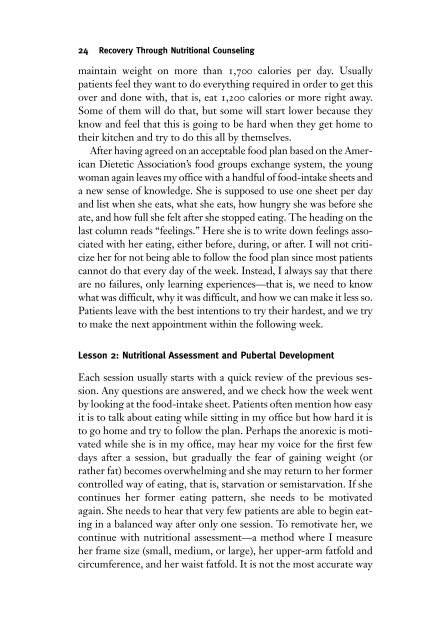Eating Disorders - fieldi
Eating Disorders - fieldi
Eating Disorders - fieldi
Create successful ePaper yourself
Turn your PDF publications into a flip-book with our unique Google optimized e-Paper software.
24 Recovery Through Nutritional Counseling<br />
maintain weight on more than 1,700 calories per day. Usually<br />
patients feel they want to do everything required in order to get this<br />
over and done with, that is, eat 1,200 calories or more right away.<br />
Some of them will do that, but some will start lower because they<br />
know and feel that this is going to be hard when they get home to<br />
their kitchen and try to do this all by themselves.<br />
After having agreed on an acceptable food plan based on the American<br />
Dietetic Association’s food groups exchange system, the young<br />
woman again leaves my office with a handful of food-intake sheets and<br />
a new sense of knowledge. She is supposed to use one sheet per day<br />
and list when she eats, what she eats, how hungry she was before she<br />
ate, and how full she felt after she stopped eating. The heading on the<br />
last column reads “feelings.” Here she is to write down feelings associated<br />
with her eating, either before, during, or after. I will not criticize<br />
her for not being able to follow the food plan since most patients<br />
cannot do that every day of the week. Instead, I always say that there<br />
are no failures, only learning experiences—that is, we need to know<br />
what was difficult, why it was difficult, and how we can make it less so.<br />
Patients leave with the best intentions to try their hardest, and we try<br />
to make the next appointment within the following week.<br />
Lesson 2: Nutritional Assessment and Pubertal Development<br />
Each session usually starts with a quick review of the previous session.<br />
Any questions are answered, and we check how the week went<br />
by looking at the food-intake sheet. Patients often mention how easy<br />
it is to talk about eating while sitting in my office but how hard it is<br />
to go home and try to follow the plan. Perhaps the anorexic is motivated<br />
while she is in my office, may hear my voice for the first few<br />
days after a session, but gradually the fear of gaining weight (or<br />
rather fat) becomes overwhelming and she may return to her former<br />
controlled way of eating, that is, starvation or semistarvation. If she<br />
continues her former eating pattern, she needs to be motivated<br />
again. She needs to hear that very few patients are able to begin eating<br />
in a balanced way after only one session. To remotivate her, we<br />
continue with nutritional assessment—a method where I measure<br />
her frame size (small, medium, or large), her upper-arm fatfold and<br />
circumference, and her waist fatfold. It is not the most accurate way









